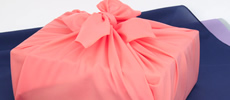Materials and Size
Traditional material for Furoshiki is silk and cotton.

Size of Furoshiki
The size of a furoshiki is generally expressed in terms of Haba. The standard unit is the width of kimono fabric (approx. 34 cm), which is the traditional Japanese dimension, and this is considered to be one haba. Today, fabrics up to 4 haba (approx. 130 cm) are manufactured on looms, and furoshiki of 5 haba (approx. 175 cm) and larger are made by joining fabrics together.
In recent years, traditional looms are no longer produced, and fabrics woven on newer looms do not have selvedge edges, resulting in fringed edges. As a result, furoshiki used to be sewn on only two sides (top and bottom), but recently four-sided sewn furoshiki have been on the rise. Furthermore, sizes that do not fit the traditional standard, such as 112 cm and 118 cm, are becoming more common.
Examples of uses for furoshiki by size
175 cm: Table cover
130 cm: Tablecloth
105 cm: Bag, tablecloth, drop bag (TSUNAGU Furoshiki bag)
90 cm: 1.8L sake bottle wrap, bag, drop bag (Furoshiki bag)
68 cm Candy box wrap, wine bottle wrap, TSUNAGU Furoshiki shoulder bag,
50cm Bento lunch box wrappers, table mats
We also have artificial fibers like rayon, polyester, acetate these days.
Chirimen; about 68cm
Cotton; about 50, 90, 100, 112, 118cm
| Material | Weave (Fabric Name) | Care Instructions |
|---|---|---|
| Silk | Chirimen, Hakusan Tsumugi |
Dry clean only |
| Synthetic Fiber | Rayon: Chirimen | Dry clean only; note that rayon shrinks when wet |
| Nylon: Nylon Dechine | ||
| Polyester: Chirimen, Tsumugi, Amundsen, Pongee | Hand wash at home | |
| Cotton | Shantung (Tsumugi-style), Broadcloth, Tenjiku, Vanillan, Tassar, Butcher | Washable at home; wash colored items separately by hand |
